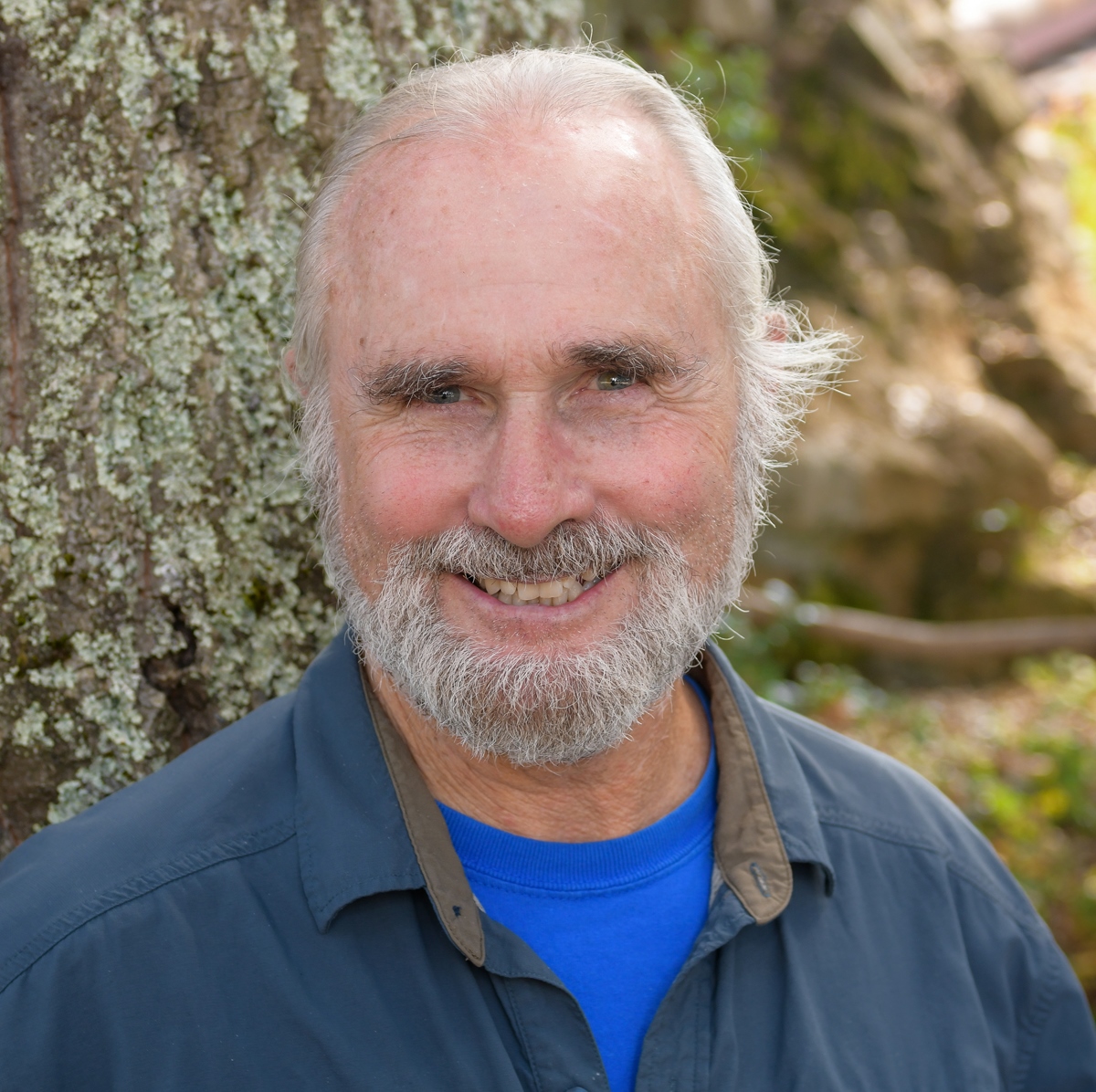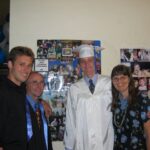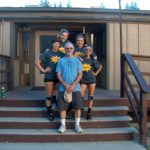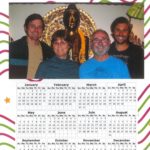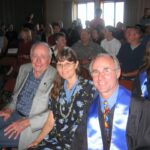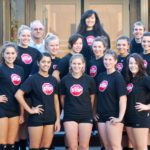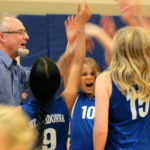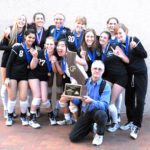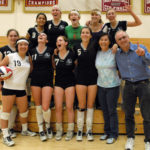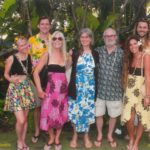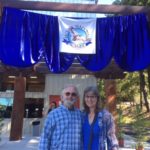 Sidd McDonald, middle and high school math teacher and volleyball coach, joined Mount Madonna School in 2003 and is retiring at the end of the current school year. Alumna Alexis Julien (’15) spoke with McDonald in December 2019, and wrote the following candid portrait.
Sidd McDonald, middle and high school math teacher and volleyball coach, joined Mount Madonna School in 2003 and is retiring at the end of the current school year. Alumna Alexis Julien (’15) spoke with McDonald in December 2019, and wrote the following candid portrait.
It was thirty minutes past our meeting time when Sidd McDonald finally arrived at the Community Building at Mount Madonna Center (MMC), clad in his usual flannel and flip flops despite the light rain outside. He offered a brief apology, delivered with his signature mischievous grin — he was deeply engrossed in a book, losing all conception of space and time.
“You just wanted to get out of talking about yourself,” I laughed. Sidd gave me another grin, but he didn’t deny it. We headed inside, grabbing two mugs of tea as we sat down in the dining hall.
“Alright,” he said, leaning back in his chair. “So where do we start?”
 Where does one start with Sidd McDonald, one of Mount Madonna’s most beloved and colorful figures? Over the course of his life, he has held countless titles and roles — teacher, school athletic director, engineer. Yogi, activist, volleyball club director, coach, father. The richness of his story is daunting, and to excavate such an illustrious life, there is only one place at which we can start: the beginning.
Where does one start with Sidd McDonald, one of Mount Madonna’s most beloved and colorful figures? Over the course of his life, he has held countless titles and roles — teacher, school athletic director, engineer. Yogi, activist, volleyball club director, coach, father. The richness of his story is daunting, and to excavate such an illustrious life, there is only one place at which we can start: the beginning.
The constant motif of Sidd’s childhood was movement. His father was a naval officer, and Sidd, his three siblings, and parents were in a perpetual cycle of uprooting and moving to a new part of the country every few years. “It was very much a gypsy life,” Sidd recalled. “When you’re doing the naval lifestyle, you move all the time.”
Sidd was born in Quonset Point, Rhode Island, but his earliest memories are in Del Rey Oaks in Monterey. His elementary school years were spent running barefoot around Hawaii, and as a young teen his family moved in rapid succession to Virginia and Connecticut before returning to Hawaii once more.
With two years of high school left, Sidd and his family moved once again, migrating to northern Virginia for the second time. Sidd graduated from high school there in 1969 — a year that was a particularly interesting time to come of age in the U.S. In the late 1960s, the Vietnam War was going strong, as was the debate that surrounded the war itself. Coming of age amidst one of the most socially divisive wars in American history had a significant impact on Sidd, particularly given his family’s military background.
 “Vietnam was the beginning of when I began to think along different lines from how I was brought up,” he said. “I became strongly antiwar during that time. I was concerned about excess militarism, and that created some tension between me and my parents.”
“Vietnam was the beginning of when I began to think along different lines from how I was brought up,” he said. “I became strongly antiwar during that time. I was concerned about excess militarism, and that created some tension between me and my parents.”
As his social consciousness and interest in activism grew, Sidd was also preparing to embark on a critical milestone of young adulthood: college. He attended Duke University in Durham, North Carolina. His time at Duke, however, was brief. Aside from the school being too far from the coast for his liking — a six-hour drive from the ocean was unacceptable — Sidd felt out of place in Duke’s conservative, southern environment. He moved on to Melbourne, Florida, where he attended community college.
After finishing his studies in Florida, Sidd’s journey to completing his college education experienced a hiatus.
“It was a long road for me to get through college,” he said. “I did some interesting things during that time, such as studying yoga, and becoming more involved in activism and other political arenas.”
With his education paused, Sidd moved to Seattle, where he found work as a machinist in a factory making industrial winches. It was in Seattle that Sidd met his future wife, Supriya. Supriya had recently graduated from Western Washington University, and was working as a teacher. About a year after their initial meeting, the couple began their relationship.
 In 1981, a chance encounter became a life altering moment for Sidd: at SeaTac Airport, Sidd and Supriya met Baba Hari Dass, the teacher who inspired the founding of MMC. Baba Hari Dass was traveling through Washington at the time, and after studying under him and learning about MMC, Sidd’s intrigue led him to visit the Center for the first time.
In 1981, a chance encounter became a life altering moment for Sidd: at SeaTac Airport, Sidd and Supriya met Baba Hari Dass, the teacher who inspired the founding of MMC. Baba Hari Dass was traveling through Washington at the time, and after studying under him and learning about MMC, Sidd’s intrigue led him to visit the Center for the first time.
Following that visit, Sidd returned to Washington and continued to think about the Center — and the Center, as it turns out, was also thinking about him. Not long after this, Sidd received a letter from Baba Hari Dass informing him that the Center’s program house had burned down, and they needed workers to help rebuild it. He asked Sidd, who was working in construction doing plumbing at the time, for his assistance. That summer, Sidd and Supriya traveled to California and stayed at the Center, helping to rebuild facilities, while building new connections of their own. Those summer months on the mountain left the couple with a determination that stayed with them as they returned to Washington: as soon as they were able to, they would permanently move to MMC.
 “We knew we had found a place that was a better fit for us than where we were at the time,” Sidd explained. “While we had friends in Seattle, we weren’t immersed in a community that closely aligned with our interests and philosophies. The Center was different, and we were interested in being a part of its growth and its community.”
“We knew we had found a place that was a better fit for us than where we were at the time,” Sidd explained. “While we had friends in Seattle, we weren’t immersed in a community that closely aligned with our interests and philosophies. The Center was different, and we were interested in being a part of its growth and its community.”
In 1987, five years after their first summer on the mountain, the McDonalds, now a group of four with the addition of sons Kai and Elliot (“PK”), moved to MMC. Sidd had finished his electrical engineering degree at Seattle University, and he immediately began working in Silicon Valley, starting first with an automotive electronics firm before moving to Mitsubishi Electronics, where he worked on semiconductors and memory products.
For sixteen years, Sidd faced a grueling commute every day: he would drive down the mountain to the Morgan Hill Caltrain station, take the train for an hour to Sunnyvale, and then walk an additional 40 minutes from the station to work — repeated, in reverse, at the end of each workday. It is not with a grimace that Sidd recalls this, however. When speaking about his time in Silicon Valley, Sidd focuses on the valuable lessons he learned while immersed in the technology powerhouse of the world. One such lesson is the importance of leadership.
“Our work was high stakes, high profit, and extremely competitive, and all this made leadership incredibly important,” he said. “Decisions at the top had the ability to break us, and sometimes they nearly did. Experiencing extreme rises and drastic falls taught me that leadership really counts, and decisions are really important. Everyone has to work to make things happen, but if you don’t have enlightened leadership, leaders who are forward thinking and open to change, things down the road won’t go so well.”
 In the early 2000s, Sidd decided it was time to move on from Mitsubishi. His oldest son, Kai, had just finished college at the Massachusetts Institute of Technology, and PK was heading to the University of California, Los Angeles. For Sidd, this felt like the opportune moment to leave Silicon Valley behind and venture into a new and equally challenging profession: teaching.
In the early 2000s, Sidd decided it was time to move on from Mitsubishi. His oldest son, Kai, had just finished college at the Massachusetts Institute of Technology, and PK was heading to the University of California, Los Angeles. For Sidd, this felt like the opportune moment to leave Silicon Valley behind and venture into a new and equally challenging profession: teaching.
Sidd joined the Mount Madonna School (MMS) faculty in 2003, primarily teaching high school math and the occasional science course. While he immediately fell in love with the job and the students he worked with, Sidd remembers how surprised he was by the challenges of this new path.
“One thing about the teaching profession is that it is all-absorbing,” commented Sidd. “I worked three times as hard in the classroom as I did at Mitsubishi, and made a quarter of what I had earned previously.”
“But being a teacher is like being a poet — if you’re going to be a poet, you’ve got to be a poet. You’re going to be starving and it’s going to be a long road, but it will be worth it. It’s always worth it.”
 Shortly after joining MMS, Sidd was asked to take on the additional role as the school’s athletic director. As soon as he started this position, he was presented with his first challenge: the girls volleyball program. At that time, the team was a far cry from 2019’s state championship win; the girls team hadn’t won a match in years, and drastic changes needed to be made.
Shortly after joining MMS, Sidd was asked to take on the additional role as the school’s athletic director. As soon as he started this position, he was presented with his first challenge: the girls volleyball program. At that time, the team was a far cry from 2019’s state championship win; the girls team hadn’t won a match in years, and drastic changes needed to be made.
Embracing this challenge, Sidd became a critical player in turning the program around. He worked from the bottom up, starting with changes to the middle school volleyball program. He switched the middle school girls to a fall league, aligning their season with the high school’s and, in doing so, allowed middle school athletes to participate in the spring club leagues.
“After we made that switch, many of our middle school athletes began to play club, which meant they were coming back each school season stronger than ever before. This fed into our high school program, and we just grew from there. And we haven’t looked back since — two state championships!”
 After nearly two decades at MMS, Sidd will be leaving the school at the end of this school year, in solidarity with Supriya’s own retirement from her current role as head of school. He’s hesitant to use the word “retirement” for himself, but he will say that he is taking at least a year off.
After nearly two decades at MMS, Sidd will be leaving the school at the end of this school year, in solidarity with Supriya’s own retirement from her current role as head of school. He’s hesitant to use the word “retirement” for himself, but he will say that he is taking at least a year off.
“If I decide to come back, or if the school needs me to come back, then I will,” he said coyly. For now though, he is looking forward to taking some time away. He and Supriya have plans to travel, but from there the couple’s next move remains undetermined.
Our voices quieted as we entered this part of the conversation, an unconscious shift that seemed to acknowledge both how momentous and sentimental this decision is for Sidd. I asked him what he will miss about teaching, or, perhaps, what made him stick with it for so long.
He began to reminisce on students from the past and present, and a common thread through these stories is the sense of fulfillment he finds in witnessing a challenge be overcome.
 “There’s nothing like seeing a student overcome their fear,” he said. “That, for me, is the most fulfilling and important part of teaching — reaching students who have struggled in the past, who are bringing fear of failure into the classroom, and helping them to persist and become successful. That’s what makes this profession so rewarding — seeing persistence become success.”
“There’s nothing like seeing a student overcome their fear,” he said. “That, for me, is the most fulfilling and important part of teaching — reaching students who have struggled in the past, who are bringing fear of failure into the classroom, and helping them to persist and become successful. That’s what makes this profession so rewarding — seeing persistence become success.”
This idea of persistence is one that Sidd continued to circle back to throughout our conversation. It came up when we talked about his days in Silicon Valley, where he saw visionaries persistently chase after their dreams of new technologies. It arose when we discussed the success of Mount Madonna’s volleyball teams, with Sidd pointing to the programs’ humble beginnings and the hard work that led to those many banners hanging on the gym walls. It is a common theme in the anecdotes he shared about his time in the classroom, where every day he helped struggling students to find the determination to push forward.
 What goes unspoken in all of these stories, however, is that this same doggedness and tenacity that Sidd so admires in leaders, athletes, and students is reflected in his own self. It is seen in his commitment to a two-plus hour commute to Silicon Valley for over a decade. It is displayed in his journey to get a college degree, not giving up despite the years it took for him to receive a diploma. It is ramified in his work for Mount Madonna, where for nearly twenty years he has committed to helping students find success both in the classroom and on the court. That persistence that Sidd speaks to, that tenacity that he instills in his students, is not just something he admires — it is a quality that he embodies in every part of his life.
What goes unspoken in all of these stories, however, is that this same doggedness and tenacity that Sidd so admires in leaders, athletes, and students is reflected in his own self. It is seen in his commitment to a two-plus hour commute to Silicon Valley for over a decade. It is displayed in his journey to get a college degree, not giving up despite the years it took for him to receive a diploma. It is ramified in his work for Mount Madonna, where for nearly twenty years he has committed to helping students find success both in the classroom and on the court. That persistence that Sidd speaks to, that tenacity that he instills in his students, is not just something he admires — it is a quality that he embodies in every part of his life.
Our tea had grown cold when I asked Sidd a final question — if he had any parting words to share with the school community as he takes his leave. For the first time in our conversation, he didn’t immediately jump into an answer. Instead, Sidd looked out the window, fog slowly rolling into the valley below us. When he began to speak, it was slowly, with intention.
“The mountain, this mountain, wants to have kids here. I’ve always looked at the mountain and known this. And for the kids who resonate with the mountain, those who are able to reach in and touch its magic, there is an energy and joy to be found here that makes the school and the education it offers so special. The mountain wants to have kids here, and that’s how I know the school is going to last for a very long time. It’s going to be hard work, but we have the doggedness in us, as does the mountain, to make it last.”
“Be dogged,” continued Sidd, with a knowing nod, as he turned to me and gave the table a resounding knock with his knuckles. “Don’t quit. Keep at it. That is how we find success.”
###
By Alexis Julien (’15)
###
Contact: Leigh Ann Clifton, director of marketing & communications,
Nestled among the redwoods on 375 acres, Mount Madonna School (MMS) is a community of learners dedicated to creative, intellectual, and ethical growth. MMS supports its students in becoming caring, self-aware, discerning and articulate individuals; and believe a fulfilling life includes personal accomplishments, meaningful relationships and service to society. The CAIS and WASC accredited program emphasizes academic excellence, creative self-expression and positive character development. Located on Summit Road between Gilroy and Watsonville. Founded in 1979.

